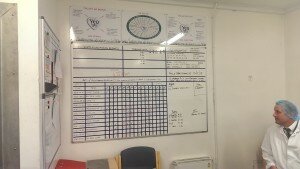By Callum Bentley
On a foggy morning in December I drove down the driveway past two sprawling fields of solar panels at the entrance to Yeo Valley’s Crewkerne Dairy in south west England, in the heart of the Somerset countryside. I was there to visit the production manager, Wayne Lloyd and his team who pack organic milk, yogurt and fruit as part of the Yeo Valley group.
Wayne had invited me to the picturesque dairy to see how Yeo Valley was implementing and using Leader Standard Work (LSW) as a part of its “One Best Way” programme to drive improvements and standardise behaviour throughout the organisation. Over a quick coffee, Wayne explained how LSW had filled a need that he had identified within his management team 18 months earlier.
“Some of the basics weren’t being completed by my team because of the amount of things that were being thrown at them on a day-to-day basis,” he explained. “More and more was being pushed at my managers, some of it by me, but we weren’t giving them the tools to handle it effectively.
“One afternoon I was talking to Chris Coles, the group continuous improvement manager, and he was saying how the whole organisation should be supporting the front line team, and not the other way around. This really resonated with me and I realised this wasn’t happening here. He told me about LSW and gave me a copy of David Mann’s book, Creating a Lean Culture. I read up on LSW, but couldn’t find a system that exactly matched our needs, so I took the basics and built from there.”
Wayne developed a system of LSW based around Yeo Valley’s operational mantra of safety, quality, service, people, plant and profit (SQSPPP).
“All of the elements are important to us, but if you asked what we were actively doing each day to control them we would have struggled to answer,” he explained. “We needed a way of structuring our days that allowed the team to complete their tasks with the full support of the other departments.
“By developing the LSW across all functions, with the same time slots aligned to similar activities, we could synchronise some of the tasks that the operational team used to have to fit in to suit someone else’s schedule.”
After quizzing Wayne on whether he could give me a direct example of this, he told me that the technical team used to schedule housekeeping audits at times when production staff were not available, and then complain that they were not being accompanied. Now the audits all happen during the quality focus hour, and the production team managers are almost always able to accompany the technical team managers on their walks.
“The audits have become much more valuable and the cross-functional relationships between technical and production have improved dramatically,” Wayne said.
But as Wayne highlights, for any dramatic management and culture change, the entire workforce must be completely engaged.
“Right from the start I knew that if I gave the team a finished system and asked them to make it work, the management team would see it as an increase to its workload. It was important that the senior managers made a commitment to making this work with their teams.

“It’s so much more than just giving people a checklist and letting them get on with it. We tried imposing daily, weekly and monthly checklists for the team before, but we did not involve the operational team in their development, or work with them to support them with their completion. This meant that the value was limited and, in some cases, became a tick box exercise with the boxes pencil whipped at the end of the day.”
As Wayne spoke more about LSW at Yeo Valley, it became clear that the only way for this system to be truly successful, which he assured me it was, was for it to be owned by all the teams involved. He told me that it was understood within the workforce, that LSW was viewed as an agreement between different levels of management on the important tasks that must be completed with a commitment from all levels of management to make it happen.
While Wayne’s enthusiasm for LSW was becoming overtly obvious, he emphasised the importance of seeing it first hand and invited me to the work floor to properly understand it and see it in action.
Our first port of call was the operational manager’s office where we met the shift manager, Kevin Hoskins. Kevin said that since LSW was introduced, he had a lot more confidence that all areas were being looked at each day.
“There is no ambiguity now, we report hourly whether the tasks for that hour have been fully completed with no incident, completed with issues found, or not completed.”
The report is done by simply adding a tick (completed), circle (completed with issues), or cross (not completed), to a visual management board in the operational manager’s office. Kevin said that before LSW was introduced, managers would act more reactively, bouncing from event to event and getting through the day.
“We were event focused, but LSW has allowed us to become task focussed. That’s not to say that we don’t still get our fair share of events.” He said. “But our focus now is on completing the firefighting properly to get rid of the things that stop us from doing our day job.”
At this point, Kevin breaks off the interview for a few moments to complete a productivity update with his team managers, saying apologetically, “unless it’s really important, I can’t stop the LSW”.

“LSW has really raised the level of the management team,” Kevin says upon his return. “It helped some managers more than others, with managers who previously were not achieving our desired standards now receiving a structure to work within and clear expectations of what they must achieve. It has also made our succession planning much more effective, the duties of the managers are so explicitly laid out that we are able to get operators to stand in for team managers when they are on holiday and complete most of the jobs. When a team manager role becomes available, we then have some great candidates who really understand what the job entails.”
But implementing such a shift in cultural and technical behaviours is never a simple, straight forward task. Getting all team members on board and embracing change will often draw out some disengaged workers.
“It’s hard to imagine working without LSW now, but it hasn’t all been easy,” Kevin said. “Although the vast majority of the team embraced LSW, there were a few people who could not adjust to the structure and accountability that LSW creates and decided to leave the business.
“We were certain that introducing LSW was right, so we kept going and started to knock off the issues that were getting in our way. In the beginning there were some days when we wouldn’t achieve more than 15 per cent of what we now know are our daily tasks.
“We kept positive and looked at what we were achieving rather than what we weren’t. To be honest, a current bad week of 15 per cent completion was probably more than we were achieving in a good week before LSW.”
I was introduced to Justine Windsor and Adrian Facey, two of Kevin’s team managers. When they were told we were here to talk about LSW, their enthusiasm for the subject was obvious. Adrian told me how LSW has given a structure to his day that previously wasn’t there. Justine explained how the team has encouraged the evolution of LSW.
“In the beginning the lists of tasks to be completed were huge. All of the jobs were important though, and by completing them all every day we became very aware of what to look out for in our areas. Now, even when I’m not completing a check, walking from one department to another I’m constantly on the lookout for issues.”
Using the same phrase I noticed Wayne use earlier, Justine explained how the management team looked at who should be responsible for the tasks on their lists by asking; “am I responsible for doing the do, or for ensuring that this job gets done”? The managers developed checklists for members of their team to complete at set times during the day, which they now randomly audit to ensure the tasks are being carried out. This allows managers time to work on the issues that are highlighted during the checks.
Justine offered to take me around on her “quality” walk so I could see how it works in practice. She walked me through the tasks that she completes during this hour every day. As we walk through the area, as well as performing her own tasks, Justine checks her operators’ checklists to ensure their tasks have been completed and then randomly picks three things on each, which she checks to verify completion.
“It’s not that we don’t trust people, I check that things have been carried out the way I want them. I’m checked by Kevin as well, this way we’re all confident that things have been done properly. It can be referred to as the roof tile approach.”
As I was leaving, I caught up again with Wayne. “Don’t forget, it’s not the finished article yet,” he cautioned “but we’re getting there.”

